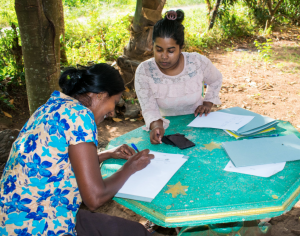Incorporating Gender At The Core Of Risk Management And Climate And Disaster Risk Finance And Insurance
Women and men face the same climate-related hazards, but often very different risks and impacts. This includes direct economic losses and damages, but also non-economic, informal, and unrecorded losses and damages, gender-based violence, or impacts on health, mental and emotional wellbeing, or displacement and climate-induced migration.
In many cases, these differential risks and impacts are connected to women’s roles in supply and value chains, their labour profiles, household responsibilities, and decision-making power. Women often have additional vulnerabilities, are more exposed, or have lesser adaptive and coping capacities due to access barriers, sociocultural differences, and other gender-specific challenges and constraints.
Putting gender at the core of risk management
For climate and disaster risk finance and insurance (CDRFI) as well as risk management in general, gender is more than a theoretical consideration. There are very real and practical differences in capacities, contributions, challenges, and constraints across key sectors, which need to be understood, and addressed. While the gendered spheres of activity are not distinct and separable, and while there are many ways in which women and men collaborate, exchange knowledge, and support each other, gender plays a significant role in the division of labour, time, and space.
Therefore, gender must be considered at the core of risk management and CDRFI design. Beyond the acknowledgement of gender as a key determinant in research and planning processes, gender-responsiveness also needs to be translated into concrete, evidence-based, well-planned, and practical actions. Gender considerations cut across all stages and levels of risk management. This includes gender-responsive insurance mechanisms and other financial instruments, but also data collection, risk analytics, planning processes, monitoring, evaluation, and impact assessments. Without identifying and incorporating gender-specific needs, vulnerabilities, challenges, constraints, capacities, and contributions, CDRFI mechanisms cannot reach their intended beneficiaries in an effective, inclusive, and equitable manner.
Towards this end, SLYCAN Tust is currently finalizing the development of a gender module that contains tools and checklists for designing gender-responsive interventions and linking them to different aspects of the UNFCCC process.
Using the gender module
As mapped out by the module, gender-responsive interventions related to risk management can fall in many categories, for example:
- Removing access barriers and structural inequalities for women;
- Providing employment opportunities, mentorship, livelihood diversification, and entrepreneurship support;
- Enhancing access to land, credit, education, information, finance, markets etc.;
- Conducting capacity-building and skills training;
- Ensuring women participation and gender-responsiveness in data collection, project design, M&E, and impact assessments;
- Developing gender-responsive CDRFI mechanisms such as women-focused (micro)insurance, cash transfer, or credit schemes;
- Creating awareness and sharing good practices and case studies of women’s contributions.

Within these categories of interventions and the various stages of development and action, gender considerations need to be identified, mapped, and addressed within the implementing agency as well as in the mechanism or intervention itself.
As an example, insurance data collection and risk mapping exercises should be conscious of gender and include relevant indicators and metrics. On the individual or household level, this can mean collecting gender-disaggregated data on household income, labour profiles, access and control, ownership of physical assets, formal and informal savings, different forms of literacy, nutritional security, consumption patterns, risk perceptions, and coping strategies. On the community level, gender considerations can include supply and value chain roles, information flows and advisory systems, gender-specific risk factors, gendered impacts of human mobility, or livelihood opportunities for women.
Furthermore, gender-responsive data collection needs to also incorporate gendered perspectives on the process and operational level. For example, this can happen through gender focal points and experts, representation and inclusion in data collection teams, validation of findings, and tapping into gender-specific sources of knowledge, such as women associations and traditional knowledge-keepers. Even if data availability is limited, this process can highlight blind spots and identify gaps and needs for enhanced data collection or extrapolation.
Building on the intervention toolkit and gender checklists, the gender module contains a number of add-ons that provide guidance on how to connect gender in risk management to the UNFCCC space, for example to the Gender Action Plan process, Action for Climate Empowerment, the Nairobi Work Programme, the Paris Committee on Capacity-Building, or the Fiji Clearing House for Risk Transfer. By making these connections, the module helps CDRFI actors and practitioners to ensure coherence of their interventions with global processes and harness synergies across different levels.
To further enhance the understanding of gender in CDRFI and risk management, SLYCAN Trust invites and welcomes the submission of case studies, good practices, and lessons learned on incorporating gender considerations into risk analytics, policies, mechanisms, schemes, financial instruments, and other interventions. If you would like to contribute, please send an email to [email protected].